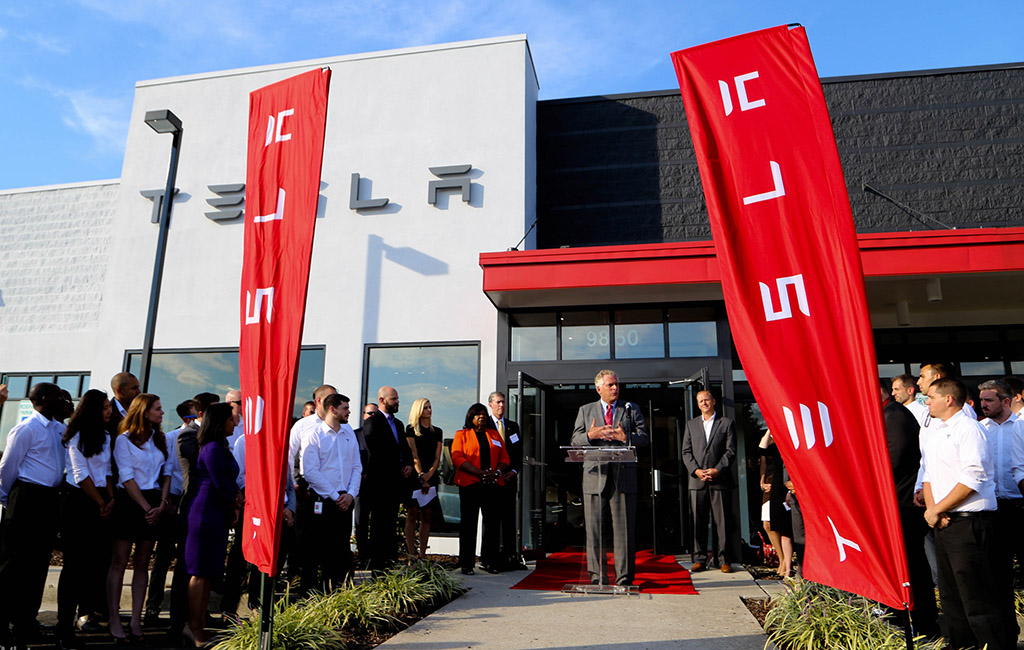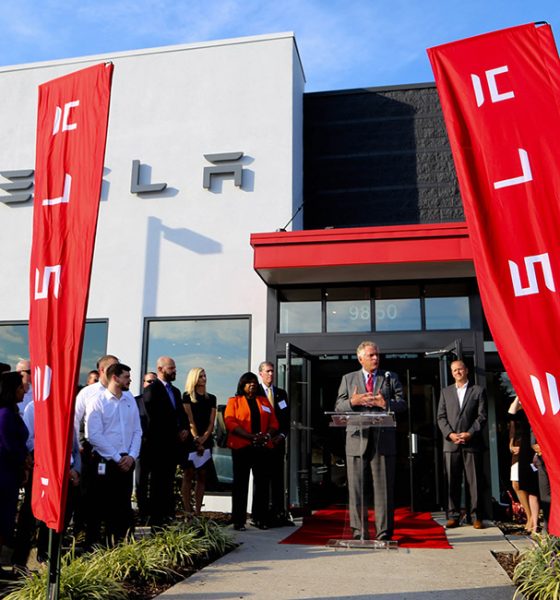

News
Tesla representative removed from auto dealer’s board by Virginia Senate
Tesla Inc. employee Cody Arnett was relieved of his post in Virginia’s Motor Vehicle Dealer Board earlier this week, amid an ongoing battle over the electric carmaker’s right to sell directly to consumers in the state. Arnett, who was appointed by former Governor Terry McAuliffe before he stepped down from office, raised some eyebrows among other members of the MVDB, many of whom felt that the Tesla employee was not qualified for the post.
His removal from the MVDB seemed to have been caused by strong opposition to Tesla’s dealership-free business model by the Virginia Automobile Dealers Association (VADA), an influential group of legacy auto dealers that holds to the notion that automakers must sell vehicles through franchised dealerships. Arnett, who currently works as a performance coach for Tesla, was set to serve for four years on Virginia’s Motor Vehicle Dealer Board. As one of the MVDB’s 19 members, Arnett was tasked with the regulation and oversight of new and used automobile dealers in the state. On January 15, however, the VADA formally submitted a request to strip the 29-year-old Tesla employee of his appointment.
According to the VADA, Arnett should not be allowed to serve on the MVDB because he was not the owner of a franchised vehicle dealership. In a statement to the Richmond Times-Dispatch, the auto group’s president and CEO, Don Hall, asserted that the technicality ultimately disqualifies the Tesla employee from holding one of the board’s 19 seats.
“The seat cannot be held by an employee of a dealer. It must be held by the owner of a dealership. I am sure the young man is a nice guy, and I am sure he has got great intentions, but the fact is he does not qualify,” Hall said, according to the Times-Dispatch.
The Virginia Automobile Dealers Association’s objection to Arnett’s appointment was submitted to Sen. Jill Holtzman Vogel, R-Fauquier, the chairwoman of the Senate Privileges and Elections Committee. Last Tuesday, the Senate committee decided to strip Arnett of his place in the MVDB, in what could only be described as a rare instance when a gubernatorial appointment was relieved from a post, as noted in a Washington Post report. Only one member of the committee, Sen. Adam Ebbin, D-Alexandria, voted to keep Arnett on the Motor Vehicle Dealer Board.
Arnett has been a longtime employee of Tesla, starting his tenure with the Elon Musk-led electric car maker and energy firm back in 2012. In a statement to the Times-Dispatch, Arnett stated that he received a dealer-operator license three years ago. He also revealed that he had already attended an MVDB meeting earlier this month.
In a statement to the Times-Dispatch on Wednesday, Tesla senior policy manager Brooke Kintz expressed the company’s disappointment at Arnett’s removal from the state’s Motor Vehicle Dealer Board.
“Arnett would have brought an important and innovative perspective to the board and to Virginians. Former Governor McAuliffe recognized this in appointing Cody, and as the holder of a license in Virginia, Tesla has just as much of a right to participate on the MVDB as anyone else.
“The decision of a small number of legislators to overturn Cody’s appointment at the urging of VADA is highly unusual if not unprecedented. It raises basic questions of fairness and improper political influence,” Kintz said.
Tesla currently operates one store at 9850 W. Broad St. in western Henrico County, Virginia, that doubles as a showroom and service center.

News
Tesla China delivery centers look packed as 2025 comes to a close
Needless to say, it appears that Tesla China seems intent on ending 2025 on a strong note.

Tesla’s delivery centers in China seem to be absolutely packed as the final days of 2025 wind down, with photos on social media showing delivery locations being filled wall-to-wall with vehicles waiting for their new owners.
Needless to say, it appears that Tesla China seems intent on ending 2025 on a strong note.
Full delivery center hints at year-end demand surge
A recent image from a Chinese delivery center posted by industry watcher @Tslachan on X revealed rows upon rows of freshly prepared Model Y and Model 3 units, some of which were adorned with red bows and teddy bears. Some customers also seem to be looking over their vehicles with Tesla delivery staff.
The images hint at a strong year-end push to clear inventory and deliver as many vehicles as possible. Interestingly enough, several Model Y L vehicles could be seen in the photos, hinting at the demand for the extended wheelbase-six seat variant of the best-selling all-electric crossover.
Strong demand in China
Consumer demand for the Model Y and Model 3 in China seems to be quite notable. This could be inferred from the estimated delivery dates for the Model 3 and Model Y, which have been extended to February 2026 for several variants. Apart from this, the Model Y and Model 3 also continue to rank well in China’s premium EV segment.
From January to November alone, the Model Y took China’s number one spot in the RMB 200,000-RMB 300,000 segment for electric vehicles, selling 359,463 units. The Model 3 sedan took third place, selling 172,392. This is quite impressive considering that both the Model Y and Model 3 are still priced at a premium compared to some of their rivals, such as the Xiaomi SU7 and YU7.
With delivery centers in December being quite busy, it does seem like Tesla China will end the year on a strong note once more.
News
Tesla Giga Berlin draws “red line” over IG Metall union’s 35-hour week demands
Factory manager André Thierig has drawn a “red line” against reducing Giga Berlin’s workweek to 35 hours, while highlighting that Tesla has actually increased its workers’ salaries more substantially than other carmakers in the country.

Tesla Giga Berlin has found itself in a new labor dispute in Germany, where union IG Metall is pushing for adoption of a collective agreement to boost wages and implement changes, such as a 35-hour workweek.
In a comment, Giga Berlin manager André Thierig drew a “red line” against reducing Giga Berlin’s workweek to 35 hours, while highlighting that Tesla has actually increased its workers’ salaries more substantially than other carmakers in the country.
Tesla factory manager’s “red line”
Tesla Germany is expected to hold a works council election in 2026, which André Thierig considers very important. As per the Giga Berlin plant manager, Giga Berlin’s plant expansion plans might be put on hold if the election favors the union. He also spoke against some of the changes that IG Metall is seeking to implement in the factory, like a 35-hour week, as noted in an rbb24 report.
“The discussion about a 35-hour week is a red line for me. We will not cross it,” Theirig said.
“(The election) will determine whether we can continue our successful path in the future in an independent, flexible, and unbureaucratic manner. Personally, I cannot imagine that the decision-makers in the USA will continue to push ahead with the factory expansion if the election results favor IG Metall.”
Giga Berlin’s wage increase
IG Metall district manager Jan Otto told the German news agency DPA that without a collective agreement, Tesla’s wages remain significantly below levels at other German car factories. He noted the company excuses this by referencing its lowest pay grade, but added: “The two lowest pay grades are not even used in car factories.”
In response, Tesla noted that it has raised the wages of Gigafactory Berlin’s workers more than their German competitors. Thierig noted that with a collective agreement, Giga Berlin’s workers would have seen a 2% wage increase this year. But thanks to Tesla not being unionized, Gigafactory Berlin workers were able to receive a 4% increase, as noted in a CarUp report.
“There was a wage increase of 2% this year in the current collective agreement. Because we are in a different economic situation than the industry as a whole, we were able to double the wages – by 4%. Since production started, this corresponds to a wage increase of more than 25% in less than four years,” Thierig stated.
News
Tesla is seeing a lot of momentum from young Koreans in their 20s-30s: report
From January to November, young buyers purchased over 21,000 Teslas, putting it far ahead of fellow imported rivals like BMW and Mercedes-Benz.

Tesla has captured the hearts of South Korea’s 20s-30s demographic, emerging as the group’s top-selling imported car brand in 2025. From January to November, young buyers purchased over 21,000 Teslas, putting it far ahead of fellow imported rivals like BMW and Mercedes-Benz.
Industry experts cited by The Economist attributed this “Tesla frenzy” to fandom culture, where buyers prioritize the brand over traditional car attributes, similar to snapping up the latest iPhone.
Model Y dominates among young buyers
Data from the Korea Imported Automobile Association showed that Tesla sold 21,757 vehicles to the 20s-30s demographic through November, compared to BMW’s 13,666 and Mercedes-Benz’s 6,983. The Model Y led the list overwhelmingly, with variants like the standard and Long Range models topping purchases for both young men and women.
Young men bought around 16,000 Teslas, mostly Model Y (over 15,000 units), followed by Model 3. Young women followed a similar pattern, favoring Model Y (3,888 units) and Model 3 (1,083 units). The Cybertruck saw minimal sales in this group.
The Model Y’s appeal lies in its family-friendly SUV design, 400-500 km range, quick acceleration, and spacious cargo, which is ideal for commuting and leisure. The Model 3, on the other hand, serves as an accessible entry point with lower pricing, which is valuable considering the country’s EV subsidies.
The Tesla boom
Experts described Tesla’s popularity as “fandom culture,” where young buyers embrace the brand despite criticisms from skeptics. Professor Lee Ho-geun called Tesla a “typical early adopter brand,” comparing purchases to iPhones.
Professor Kim Pil-soo noted that young people view Tesla more as a gadget than a car, and they are likely drawn by marketing, subsidies, and perceived value. They also tend to overlook news of numerous recalls, which are mostly over-the-air software updates, and controversies tied to the company.
Tesla’s position as Korea’s top import for 2025 seems secured. As noted by the publication, Tesla’s December sales figures have not been reported yet, but market analysts have suggested that Tesla has all but secured the top spot among the country’s imported cars this year.








